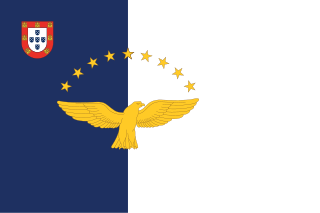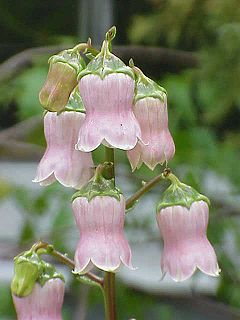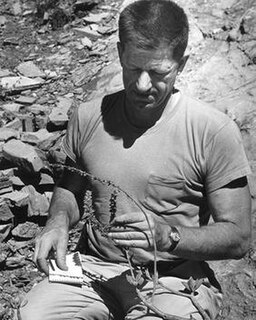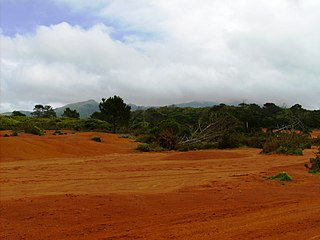
The Azores, officially the Autonomous Region of the Azores, is one of the two autonomous regions of Portugal. It is an archipelago composed of nine volcanic islands in the Macaronesia region of the North Atlantic Ocean, about 1,400 km (870 mi) west of Lisbon, about 1,500 km (930 mi) northwest of Morocco, and about 1,930 km (1,200 mi) southeast of Newfoundland, Canada.

Aichryson is a genus of about 15 species of succulent, subtropical plants, mostly native to the Canary Islands, with a few in the Azores, Madeira and Morocco.

Monanthes is a genus of small, succulent, subtropical plants of the family Crassulaceae. The about ten species are mostly endemic to the Canary Islands and Savage Islands, with some found on Madeira. Its center of diversity is Tenerife, with seven species occurring on this island. On Fuerteventura and Lanzarote, only M. laxiflora occurs. Monanthes is a rare example where a species re-colonizes the continent from an island, after their ancestors have colonized the island from the continent.

Azorina is a monotypic genus of flowering plants within the family Campanulaceae, whose sole species, Azorina vidalii, the Azores Bellflower, is endemic to the Azores. Its fragmented population is made up of fewer than 1000 mature plants limited to the coastlines of several of the islands. It is also the only species in this family native to the Azores.

Dudleya abramsiisubsp. setchellii, known by the common name Dudleya setchellii, the Santa Clara Valley dudleya, or Santa Clara Valley liveforever, is a member of the Dudleya genus of succulent perennials, members of the family Crassulaceae. The Santa Clara Valley dudleya, endemic to the Santa Clara Valley region in the southern San Francisco Bay Area, was listed on February 3, 1995, as an endangered species. It is considered to be a subspecies of Dudleya abramsii, but its taxonomic status is still unclear. Its closest relative is Dudleya cymosa subsp. paniculata, which is a morphologically similar sister taxon.

Juniperus brevifolia, the Azores juniper, is a species of juniper, endemic to the Azores, where it occurs at altitudes of 240–800 m, rarely up to 1,500 m. It is closely related to Juniperus oxycedrus of the Mediterranean region and Juniperus cedrus of the neighboring Macaronesian islands. It is threatened by habitat loss.

Kalanchoe farinacea is a species of plant in the family Crassulaceae. It is endemic to the Yemeni island of Socotra. Its natural habitat is subtropical or tropical dry shrubland at an altitude of 100-800m. While it is listed by International Union for Conservation of Nature(IUCN) as belonging to the order Rosales, Kalanchoes and other Crassulaceae are more usually placed in Saxifragales.

Kalanchoe robusta is a species of plant in the family Crassulaceae. It is endemic to the Yemeni island of Socotra. Its natural habitat is on rocky slopes and amongst limestone boulders in dwarf shrubland and low succulent shrubland at an altitude of 300–750m. While it is listed by IUCN as belonging to the order Rosales, Kalanchoes and other Crassulaceae are more usually placed in Saxifragales.

The Gibraltar Botanic Gardens or La Alameda Gardens are a botanical garden in Gibraltar, spanning around 6 hectares. The Rock Hotel lies above the park.

Dudleya candelabrum is a succulent plant known by the common name Candleholder liveforever. This Dudleya is endemic to California, where it grows wild only on the northern Channel Islands.

The Botanical Garden of Faial is an ecological garden, component of the Faial Nature Park, established in 1986 to educate and protect the biodiversity common on Faial, an island of the Azores archipelago.

Reid Venable Moran was an American botanist and the curator of botany at the San Diego Natural History Museum from 1957 to 1982.

Euphorbia stygiana is a species of evergreen shrub in the family Euphorbiaceae, endemic to several islands of the Azores. It has a critically endangered subspecies with only 20 known remaining mature individuals in the wild.

Sedum villosum, known as the hairy stonecrop or purple stonecrop, is a biennial to perennial flowering plant. Its leaves, which are 3–8 mm (0.1–0.3 in) long and may be reddish in colour, are generally covered with hairs, although S. villosum var. glabratum may have hairless leaves. Individual flowers have five pink petals, each up to 5 mm (0.2 in) long.

The Protected Landscape of Barreiro da Faneca is a geological region and protected landscape of the Portuguese island of Santa Maria, Azores. The protected area is given its name by the Barreiro da Faneca, nicknamed the "Red Desert of the Azores", an arid and clayey landscape formed during the Pliocene, unique not only to the island but to all of Portugal.

Aeonium balsamiferum is a species of tropical flowering plant in the family Crassulaceae. The species is endemic in the Canary Islands.
Aichryson bollei is a species of herbaceous flowering plants in the family Crassulaceae. It is endemic to the island of La Palma, Canary Islands. The species was first published by the German botanist Carl August Bolle in 1859 after an earlier description by Philip Barker Webb.

The Azores temperate mixed forests is a temperate broadleaf and mixed forests ecoregion of southwestern Europe. It encompasses the Azores archipelago in the Atlantic Ocean. These volcanic islands are an autonomous region of Portugal, and lie 1500 km west of the Portuguese mainland.

Dudleya pachyphytum is an insular succulent plant known by the common name Cedros Island liveforever. It is a member of the genus Dudleya endemic to the foggy northern end of Cedros Island, occupying an ecological niche shared with the Cedros Island Pine. The plant is threatened by poaching from organized criminals, including South Korean nationals and criminal gangs operating under the Mexican cartels. Demand from succulent collectors in East Asia have led to overexploitation of the plant in the wild, and armed conflict between competing poachers has sparked killings of several people.
Aichryson santamariensis is a species of plant endemic to the island of Santa Maria in the Azores. This species was previously part of the similar Aichryson villosum, restricted now only to the neighboring Madeira.


















